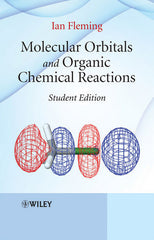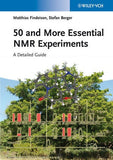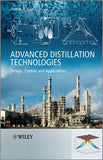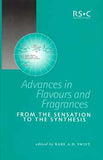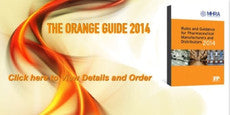Molecular Orbitals and Organic Chemical Reactions, Student Edition by Ian Fleming
Molecular Orbitals and Organic Chemical Reactions, Student Edition
Acknowledging the very best in professional and scholarly publishing, the annual PROSE Awards recognise publishers' and authors' commitment to pioneering works of research and for contributing to the conception, production, and design of landmark works in their fields. Judged by peer publishers, librarians, and medical professionals, Wiley are pleased to congratulate Professor Ian Fleming, winner of the PROSE Award in Chemistry and Physics for Molecular Orbitals and Organic Chemical Reactions.
Molecular orbital theory is used by chemists to describe the arrangement of electrons in chemical structures. It is also a theory capable of giving some insight into the forces involved in the making and breaking of chemical bonds—the chemical reactions that are often the focus of an organic chemist's interest. Organic chemists with a serious interest in understanding and explaining their work usually express their ideas in molecular orbital terms, so much so that it is now an essential component of every organic chemist's skills to have some acquaintance with molecular orbital theory.
Molecular Orbitals and Organic Chemical Reactions is both a simplified account of molecular orbital theory and a review of its applications in organic chemistry; it provides a basic introduction to the subject and a wealth of illustrative examples. In this book molecular orbital theory is presented in a much simplified, and entirely non-mathematical language, accessible to every organic chemist, whether student or research worker, whether mathematically competent or not. Topics covered include:
- Molecular Orbital Theory
- Molecular Orbitals and the Structures of Organic Molecules
- Chemical Reactions — How Far and How Fast
- Ionic Reactions — Reactivity
- Ionic Reactions — Stereochemistry
- Pericyclic Reactions
- Radical Reactions
- Photochemical Reactions
"These books are the result of years of work, which began as an attempt to write a second edition of my 1976 book Frontier Orbitals and Organic Chemical Reactions. I wanted to give a rather more thorough introduction to molecular orbitals, while maintaining my focus on the organic chemist who did not want a mathematical account, but still wanted to understand organic chemistry at a physical level. I'm delighted to win this prize, and hope a new generation of chemists will benefit from these books."
-Professor Ian Fleming
1 Principles.
1.1 The Orbital Model.
1.2 Mathematical Methods.
1.3 Basic Postulates.
1.4 Physical Interpretation of the Basic Principles.
2 Matrices.
2.1 Definitions and Elementary Properties.
2.2 Properties of Determinants.
2.3 Special Matrices.
2.4 The Matrix Eigenvalue Problem.
3 Atomic Orbitals.
3.1 Atomic Orbitals as a Basis for Molecular Calculations.
3.2 Hydrogen-like Atomic Orbitals.
3.3 Slater-type Orbitals.
3.4 Gaussian-type Orbitals.
4 The Variation Method.
4.1 Variational Principles.
4.2 Nonlinear Parameters.
4.3 Linear Parameters and the Ritz Method.
4.4 Applications of the Ritz Method.
Appendix: The Integrals J, K, J´ and K´.
5 Spin.
5.1 The Zeeman Effect.
5.2 The Pauli Equations for One-electron Spin.
5.3 The Dirac Formula for N-electron Spin.
6 Antisymmetry of Many-electron Wavefunctions.
6.1 Antisymmetry Requirement and the Pauli Principle.
6.2 Slater Determinants.
6.3 Distribution Functions.
6.4 Average Values of Operators.
7 Self-consistent-field Calculations and Model Hamiltonians.
7.1 Elements of Hartree–Fock Theory for Closed Shells.
7.2 Roothaan Formulation of the LCAO–MO–SCF Equations.
7.3 Molecular Self-consistent-field Calculations.
7.4 H€uckel Theory.
7.5 A Model for the One-dimensional Crystal.
8 Post-Hartree–Fock Methods.
8.1 Configuration Interaction.
8.2 Multiconfiguration Self-consistent-field.
8.3 Møller–Plesset Theory.
8.4 The MP2-R12 Method.
8.5 The CC-R12 Method.
8.6 Density Functional Theory.
9 Valence Bond Theory and the Chemical Bond.
9.1 The Born–Oppenheimer Approximation.
9.2 The Hydrogen Molecule H<sub>2</sub>.
9.3 The Origin of the Chemical Bond.
9.4 Valence Bond Theory and the Chemical Bond.
9.5 Hybridization and Molecular Structure.
9.6 Pauling’s Formula for Conjugated and Aromatic Hydrocarbons.
10 Elements of Rayleigh–Schroedinger Perturbation Theory.
10.1 Rayleigh–Schroedinger Perturbation Equations up to Third Order.
10.2 First-order Theory.
10.3 Second-order Theory.
10.4 Approximate E2 Calculations: The Hylleraas Functional.
10.5 Linear Pseudostates and Molecular Properties.
10.6 Quantum Theory of Magnetic Susceptibilities.
Appendix: Evaluation of µ and ε.
11 Atomic and Molecular Interactions.
11.1 The H–H Nonexpanded Interactions up to Second Order.
11.2 The H–H Expanded Interactions up to Second Order.
11.3 Molecular Interactions.
11.4 Van der Waals and Hydrogen Bonds.
11.5 The Keesom Interaction.
12 Symmetry.
12.1 Molecular Symmetry.
12.2 Group Theoretical Methods.
12.3 Illustrative Examples.
References.
Author Index.
Subject Index.
- Provides a first course in this important topic
- Extends the “frontier orbital” approximation of Fleming’s classic “Frontier Orbitals” to encompass the wider field of molecular orbitals.
- Fully updated with a wealth of recent illustrative examples
- Includes key references and suggested further reading for students to find out more
- A greater emphasis is put on chemistry than on quantum mechanics, and the intelligent use of the rules rather than their mathematical derivation.

